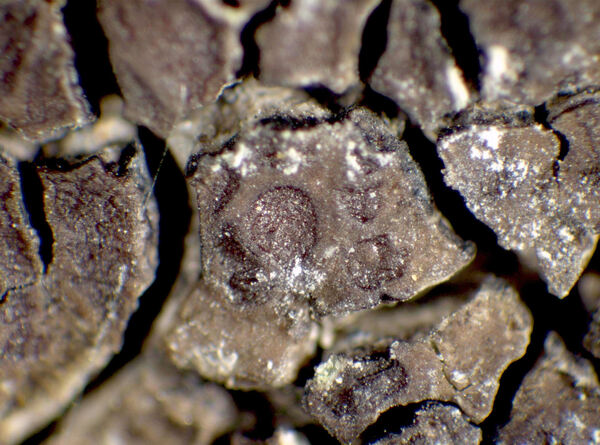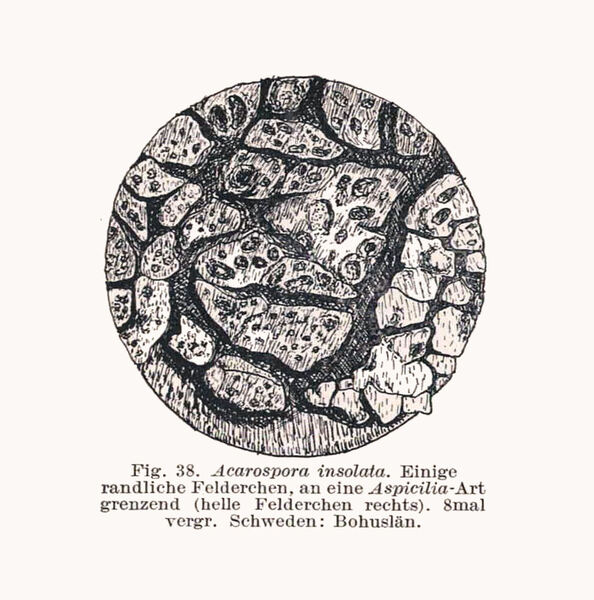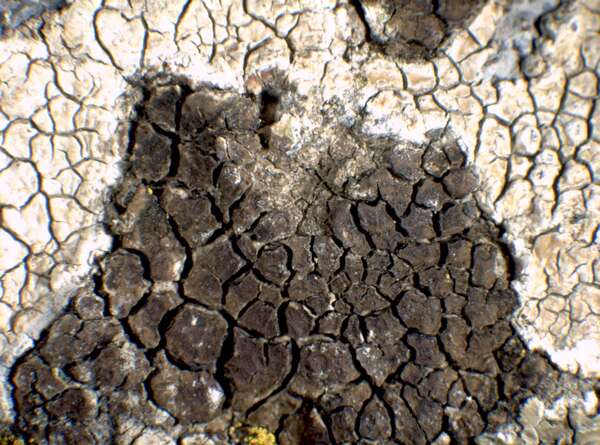Acarospora insolata H. Magn.
Göteb. Vetensk.-och Vitter.-Handl., ser. 4, 28, 2: 112, 1924.
Synonyms:
Description: Thallus crustose-subsquamulose, episubstratic areolate, medium brown, shiny, forming small patches, usually developing on the thalli of other crustose lichens. Areoles angular or rounded, slightly convex, 0.4-1.5(-3) x 0.3-2.4 mm, finely subdivided into smaller units by a dense network of fissures, dispersed or aggregated into small groups amongst the areoles of the host; lower surface black, visible along the margins. Cortex 20-30(-50) μm thick, overlain with a to 15 μm thick amorphous layer, the cortical cells 2-3 μm wide; algal layer continuous; medulla white, without crystals. Apothecia 0.2-0.4 mm across, immersed in the areoles, (2-)5-12 per areole, often confluent and poorly developed, round to elongate, with an initially concave, then flat, reddish brown disc, and a more or less prominent, sometimes indistinct thalline margin. Proper exciple thin, poorly developed; epithecium brown; hymenium colourless, 50-60(-80) μm high, euamyloid, IKI+ persistently blue; paraphyses stout, 2-2.5 μm thick at base, the apical cells to c. 3 μm wide; subhymenium and hypothecium colourless. Asci c. 100-spored, clavate, the apical dome K/I-. Ascospores 1-celled, hyaline, broadly ellipsoid, 3-5 x 2-3.5 μm. Photobiont chlorococcoid. Spot tests: cortex and medulla K-, C-, KC-, P-, UV-. Chemistry: without lichen substances.
Growth form: Crustose
Substrata: rocks
Photobiont: green algae other than Trentepohlia
Reproductive strategy: mainly sexual
Subcontinental: restricted to areas with a dry-subcontinental climate (e.g. dry Alpine valleys, parts of Mediterranean Italy)
paras Immersaria and Rhizocarpon spp.
Commonnes-rarity: (info)
Alpine belt: rather rare
Subalpine belt: rare
Montane belt: very rare
Dry submediterranean belt: extremely rare
Humid submediterranean belt: extremely rare
Padanian area: absent
pH of the substrata:
1 2 3 4 5
Solar irradiation:
1 2 3 4 5
Aridity:
1 2 3 4 5
Eutrophication:
1 2 3 4 5
Poleotolerance:
0 1 2 3
Altitudinal distribution:
1 2 3 4 5 6
Rarity
absent
extremely rare
very rare
rare
rather rare
rather common
common
very common
extremely common
Loading data...
Occurrence data
Predictive map
Growth form: Crustose
Substrata: rocks
Photobiont: green algae other than Trentepohlia
Reproductive strategy: mainly sexual
Subcontinental: restricted to areas with a dry-subcontinental climate (e.g. dry Alpine valleys, parts of Mediterranean Italy)
paras Immersaria and Rhizocarpon spp.
Commonnes-rarity: (info)
Alpine belt: rather rare
Subalpine belt: rare
Montane belt: very rare
Dry submediterranean belt: extremely rare
Humid submediterranean belt: extremely rare
Padanian area: absent
pH of the substrata:
| 1 | 2 | 3 | 4 | 5 |
Solar irradiation:
| 1 | 2 | 3 | 4 | 5 |
Aridity:
| 1 | 2 | 3 | 4 | 5 |
Eutrophication:
| 1 | 2 | 3 | 4 | 5 |
Poleotolerance:
| 0 | 1 | 2 | 3 |
Altitudinal distribution:
| 1 | 2 | 3 | 4 | 5 | 6 |
Rarity
absent
extremely rare
very rare
rare
rather rare
rather common
common
very common
extremely common
Loading data...
Occurrence data
Predictive map









